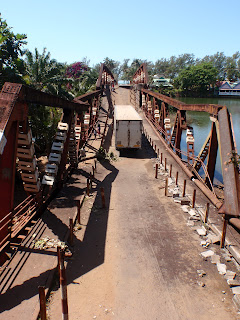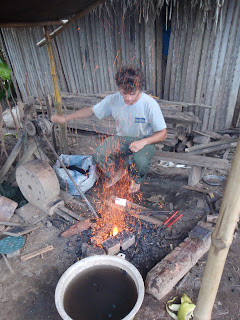Back in Ambalona, nearly 3 months of drought has come to an end. Late October and early November usually signal the beginning of the rainy season, and for me this means that gardening just got a whole lot easier, but it also means a that roof once again leaks. Planning ahead however I purchased a rainbarrel in Fianar. After strapping to my bike rack and biking it through a tourist littered 40K, I have since installed it on the shady south side of my house in. It collects water from my showers tin roof via 2" PVC gudders, and after a good night of rain I'm left with 175L of water to quench my gardens thirst.
"We're really going to fly down the hills with this stuff Russ"
Back home as the hills are set ablaze with autumn's pallet of from gold to crimson, sadly too are hills around my village in annual fires or Tavy. Typically the land is burned to clear new lands for rice cultivation or establish new pastures for the abundant cattle, but I can't see how it adds up. Much of the land surrounding my site has already been cleared, and the few trees left in the valleys look to be the seeds of reforestation, however the land is still burned. Many in my village have spent entire nights fighting the fires armed only with large ravinala leaves in order to try and snuff it out, but the next night the hills are again mysteriously set ablaze by an anonymous arsonist. Education looks to be the answer but I can only assume that those set fire to the land take similar regard for schooling. As the rains come the fires will again cease, but it only makes reforestation here in Madagascar even more challenging.
7K South of Ambalona
With the rains also comes stagnant water, and with stagnant water comes a significant spike in mosquito populations. So right now many volunteers including myself are briefing our community on malaria's symptoms and its prevention. Here in Madagascar, malaria accounts for 15 percent of all hospital visits, however due to its cyclical nature many cases go untreated thus increasing the number of human hosts that can thus transmit it to new mosquito carriers, further increasing the prevalence of malaria in the region. The first step we take is to inform communities about how to prevent exposure to malaria carrying mosquitoes (bed nets, neem cream, closed windows at night) and how to prevent breeding environments (covering water buckets,), then we inform them about its symptoms and treatment. We currently are doing this with community murals, and neem cream and bed net installation demonstration. This preparation is all leading to an upcoming bed net distribution which will help achieve the goals set forth in the President's Malaria Initiative which aims to cut Africa's malaria related deaths in half over 10 years.
They get a free paint job too
Salama
Nick















